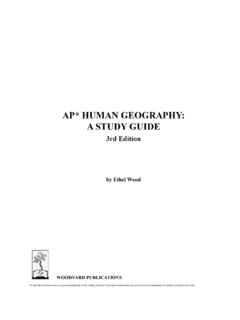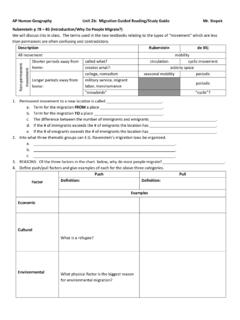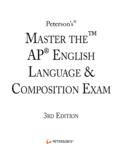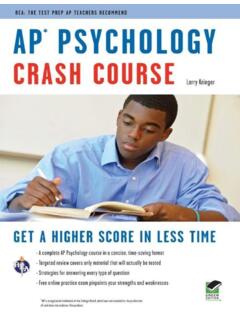Transcription of AP U.S. History Syllabus - Lee Academy
1 AP History Syllabus Course Description: advanced placement united states History is a challenging course that is meant to be the equivalent of a freshman college course and can earn students college credit. It is a two- semester survey of American History from the migration of Native Americans across the Beringia to the present time. Solid reading and writing skills, along with a willingness to devote considerable time to homework and study, are necessary to succeed. Emphasis is placed on critical and analytical thinking skills, essay writing, and on interpretation of primary and secondary sources. Course Objectives: Student will: Master a broad body of historical knowledge Demonstrate an understanding of historical chronology Use historical data to support an argument or position Interpret and apply data from original documents Prepare for and successfully pass the AP Exam Course Texts and Readings: Bailey, Thomas A.
2 , Cohen, Lizabeth, Kennedy, David M. The American Pageant. 12th ed. Boston: Houghton Mifflin Company, 2002. Bailey, Thomas A., Kennedy, David M. The American Spirit: Since 1865, Volume II. 10th ed. Boston: Houghton Mifflin Company, 2005. Bailey, Thomas A., Kennedy, David M. The American Spirit: united states History as Seen by Contemporaries, Volume I: to 1877. 10th ed. Boston: Houghton Mifflin Company, 2005. Davidson, James West, Lytle, Mark Hamilton. After the Fact: The Art of Historical Detection. Columbus: MCGraw-Hill, 1992. Dollars, Charles M., Reichard, Gary W. American Issues: A Documentary Reader. Columbus: McGraw-Hill/Glencoe, 1994. Maddox, Robert James. American History Volume I: Precolonial through Reconstruction.
3 13th ed. University Park: Penn State University, 1995. Other Materials: Assortment of power point presentations, videos, and handouts. Grading: 50% Papers and Essays Papers will be based on the DBQ (Document Based Questions). format that is used on the AP Exam. Some of the DBQ's will be timed in class assessments and others will be completed at home. The other writing activities will be based on the free response essays. They too will be timed and be administered both in class and outside as well. 50% Tests Chapter and Unit tests will be given. The format will be objective questions . mainly multiple choice. advanced placement Exam: The AP Exam is given in May. The exam is three hours and five minutes long. Exam Format: 80 Multiple Choice Questions (55 minutes).
4 Free Response Essay Section (130 minutes). DBQ (60 minutes). Read and analyze (15 minutes). Write essay (45 minutes). Essay Questions answering 2 of 4 essays (70 minutes). There is a cost involved with taking the test. Course Outline Semester 1 18 weeks 12 Themes to be identified, analyzed, critically thought about, written about, and discussed: American Diversity The diversity of the American people and the relationships among different groups. The roles of race, class, ethnicity, and gender in the History of the united states . American Identity Views of the American national character and ideas about American exceptionalism. Recognizing regional differences within the context of what it means to be American. Culture Diverse individual and collective expressions through literature, art, philosophy, music, theater, and film throughout History .
5 Popular culture and the dimensions of cultural conflict within American society. Demographic Changes Changes in birth, marriage, and death rates; life expectancy and family patterns; population size and density. The economic, social, and political effects of immigration, internal migration, and migration networks. Economic Transformations Changes in trade, commerce, and technology across time. The effects of capitalist development, labor and unions, and consumerism. Environment Ideas about the consumption and conservation of natural resources. The impact of population growth, industrialization, pollution, and urban and suburban expansion. Globalization Engagement with the rest of the world from the fifteenth century to the present: colonialism, mercantilism, global hegemony, development of markets, imperialism, and cultural exchange.
6 Politics and Citizenship Colonial and revolutionary legacies, American political traditions, growth of democracy, and the development of the modern state. Defining citizenship. Struggles for civil rights. Reform Diverse movements focusing on a broad range of issues, including anti-slavery, education, labor, temperance, women's rights, civil rights, gay rights, war, public health, and government. Religion The variety of religious beliefs and practices in American from prehistory to the twenty-first century; influence of religion on politics, economics, and society. Slavery and Its Legacies in North America Systems of slave labor and other forms of unfree labor ( , indentured servitude, contract labor) in Native American societies, the Atlantic World, and the American South and West.
7 The economics of slavery and its racial dimensions. Patterns of resistance and the long-term economic, political, and social effects of slavery. War and Diplomacy Armed conflict from the precolonial period to the twenty-first century; impact of war on American foreign policy and on politics, economy, and society. Unit 1: Colonial History (2 Weeks). Readings Bailey, Thomas A., Cohen, Lizabeth, Kennedy, David M. The American Pageant. 12th ed. Boston: Houghton Mifflin Company, 2002. Chapters 1 to 4. Bailey, Thomas A., Kennedy, David M. The American Spirit: united states History as Seen by Contemporaries, Volume I: to 1877. 10th ed. Boston: Houghton Mifflin Company, 2005. Edwards, Jonathan. Paints the Horrors of Hell Maddox, Robert James.
8 American History Volume I: Precolonial through Reconstruction. 13th ed. University Park: Penn State University, 1995. P. 6-12, America before Columbus, US News & World Report, July 8, 1991. P. 12-17, Fernandez-Armesto, Felipe. Columbus Hero or Villain? P. 26-30, Bigham, Barbara. Colonists in Bondage: Indentured Servants in America. Early American Life, Oct. 1979. Themes 1. The emergence of American cultural traits and factors that contributed to them. 2. Emerging regional patterns and how they evolved. Contents Motives and methods of colonization: Spain, France, and Britain Push-Pull factors bringing colonists to the New World Comparison and contrast of Southern, middle, and New England political, economic, social, and religious patterns Cultural differences between Americans and Europeans Assessments 1.
9 Multiple Choice tests over the chapter information based on the format of the AP Exam. 2. Timed In-Class or out of class essays based on the Free Response Essay format (each timed essay will be 30 minutes In-class). Free Response Essay Topics 1. How did the Indian societies of the South and North America differ from European societies at the time the two came into contact? In what ways did Indians retain a world view different from that of the Europeans? 2. Examine the careers of Hernan Cortez and Francisco Pizarro and assess the reasons for their success . 3. What did England and the English settlers really want from colonization? National glory? Wealth? Adventure? A solution to social tensions? New sources of goods and trade?
10 Did they get what they wanted? 4. Did the Puritans really come to America seeking religious freedom? How did they reconcile their own religious dissent from the Church of England with their persecution of dissenters like Hutchinson and Williams? Does their outlook make them hypocrites? 5. Discuss women's lives in the seventeenth century, including economic functions, religion, marriage, and child raising. The focus might be on the economic and social importance of women in agrarian colonial communities, as well as on the legal and political restrictions that kept them tied to men. 6. Why did slavery grow to be such an important institution in colonial America? What were the effects of slavery on the Africans who were brought to the New World?








